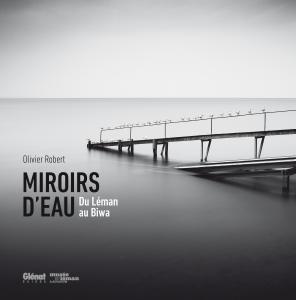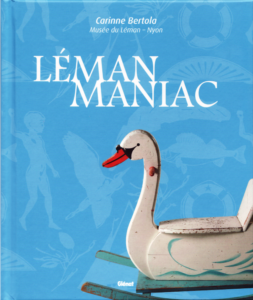Nos publications

Plouf! Ahistory of swimming in The Geneva Lake, Lionel Gauthier, Glénat, 2017.
In the summer, a few rays of sunshine are enough for the 121 bathing sites around Lake Geneva to be stormed.
But the lake has not always been so popular. Frightened or disgusted, bathers have often gone elsewhere. Others would have stung a head in this small sea of the Alps, but their time did not allow it. Blame beliefs, pollution, or morals.
This book tells the rich and colourful story of swimming in Lake Geneva. We talk about architecture, water quality, fashion and hygiene... We meet sportsmen, curists, tourists and lavenders, but also Voltaire, Hergé, Courbet, Louis XVIII, and Brigitte Bardot... We embark on a great tour of the lake over the centuries, with stopovers in Vevey, Lausanne, Geneva, Montreux, not to mention Thonon and Evian... The-Bains.

Lake Geneva, small sea of the Alps, special issue of the magazine L'Alpe, Glénat, 2016.
This spring, the magazine L'Alpe takes you to Lake Geneva. Portrait of a lake with a multi-millennial history, through a dozen articles sometimes sparkling, often surprising, always expert.
After stopping in major cities of the Alps, Grenoble, Chambéry, in massifs, such as the Écrins or the Mercantour, L'Alpe takes you on the Lake Geneva with this special issue.
Lake Geneva is of course the largest lake in the Alps, a small sea crossed by the Rhone, a "pocket ocean" whose formation dates back hundreds of thousands of years. This water mirror is also a pool of people, a place where the interweaving between nature and culture is very strong.
This issue will focus on the many facets of its long history : in the border Lake Geneva, tossed between Switzerland and France, in the festive Lake Geneva, on which naval jousting and regattas are organised, at the traditional Lake Geneva, a hunting ground for ducks, at the Léman diva, which is transformed into a filming location, in today's Geneva, the one you go through every day to get to work. Painting a lake that is not easily bottled.

Hunting on Lionel Gauthier's Lake, Glénat, 2016.
This from the magazine L'Alpe is the catalogue of the exhibition "Wanted. Hunting on the Lake" presented at the Musée du Léman from April 14, 2016 to January 8, 2017.

Edgar
Twice a year, the Association of Friends of the Museums of Nyon publishes its newspaper whose title honours the memory of Edgar Pelichet (1905-2002), former cantonal archaeologist and curator of the Museum of Lake Geneva and Nyon Castle.

Water mirrors, from Lake Geneva to Olivier Robert's Biwa (foreword by Lionel Gauthier), Glénat, 2015.
For Olivier Robert, photographing a lake is a matter of time, the weather and the one that passes. It prefers to linger on days of fog or rain, preferring long laying times.
"Photographing the world slowly is intriguing," he says. The resulting images are not the translation of the reality perceived by the eye but rather the result of the accumulation of time spent. Through the play of this slowness, the water, tormented or peaceful, draws icy horizons on which constructions, rocks or trees are embedded or reflected. Lakes become mirrors in which water and sky merge. »
Minimalist, timeless, black and white, Olivier Robert's images evoke, to the point of confusion, the Japan that inspires him, especially through sumi-e painting and historical tales Mizu Kagami ("water mirrors").
His work, exhibited at the Musée du Léman in Nyon, invites the viewer on a journey that reveals the singularity of a look and a certain universality of lake landscapes.

Edmond de Palézieux, marine painter (1850-1924), Musée du Léman, 2014.
He wanted to be a sailor and became a painter, but a navigator painter. This work, directed by his little nephew, traces the life and work of the artist.

The Golden Age of Steam Navigation on Lake Geneva (1841-1941) by Didier Zuchuat and Carinne Bertola, 2013, Glénat.
This reference book is the culmination of twenty years of research in many public and private collections. Beyond a very rich iconography on the golden age of Lake Geneva steam navigation between 1841 and 1941, this is a work of expertise unpublished using original unpublished sources. Some 280 rare photographs are presented for the first time with detailed indications and precise dating. This exceptional documentation is complemented by the technical characteristics of all steamboats built between 1823 and 1927 for the transport of passengers and goods on Lake Geneva

LémanManiac by Carinne Bertola, Glénat, 2009.
Lake Geneva has the flavour of life. Like tradition, it invents itself every day. As a religion, it is practiced to varying degrees. It has its popes and its defrocked, its chapels and rituals, its places of pilgrimage and its objects-worship. His followers like to gather in circles. Their lake habits depend for a lot on meteorology, so they are not all present at the same time on the lake and it takes a fair amount of patience to observe them all. This Lake Geneva microcosm is better known, with its perennial particularities between the Swiss or French coasts, and those of The Petit-Lac, Grand-Lac or Haut-Lac. LémanManiac is a small informal inventory of objects and documents kept by the Geneva Museum and chosen for their ability to illustrate some Lake Geneva practices. It is a subjective choice of lake symbols dating for most of the 20th century, and may one day disappear. It is also a finding. Our heritages, cultural or natural, are only perpetual reinvention. Let's keep inventing our lake every day, keeping the best of our past! This lake is not a lost paradise, it is a paradise to invent.

Switzerland, boat-salon of The Geneva by Didier Zuchuat, Glénat, 2009.
Under the name of baptism Switzerland, the General Navigation Company on Lake Geneva (CGN) has successively operated two of the most prestigious paddle-wheelboats of European lakes and rivers: these by their unrivalled dimensions and accommodations were also representative of the know-how of two Swiss manufacturers who supplied a considerable number of ships and steam engines far beyond their borders.
Of all the trade-show boats launched by Swiss manufacturers, Switzerland II (1910) has remained the object of all respects over the years thanks to the unrivalled class of its lines and the clock movement of its steam engine has never been questioned. even when it was good to "make modern."
Our publications are on sale at the museum shop.
You can also email us with the name of the book you want to order. We will send it to you as soon as possible, in exchange for payment on invoice or by credit card (plus postage).
Contact
Horaires
De 10h à 18h
Du mardi au dimanche
Fêtes de fin d'année
Fermé les 24, 25 et 31 décembre
Ouvert et entrée libre les 1, 2, 3 et 4 janvier
